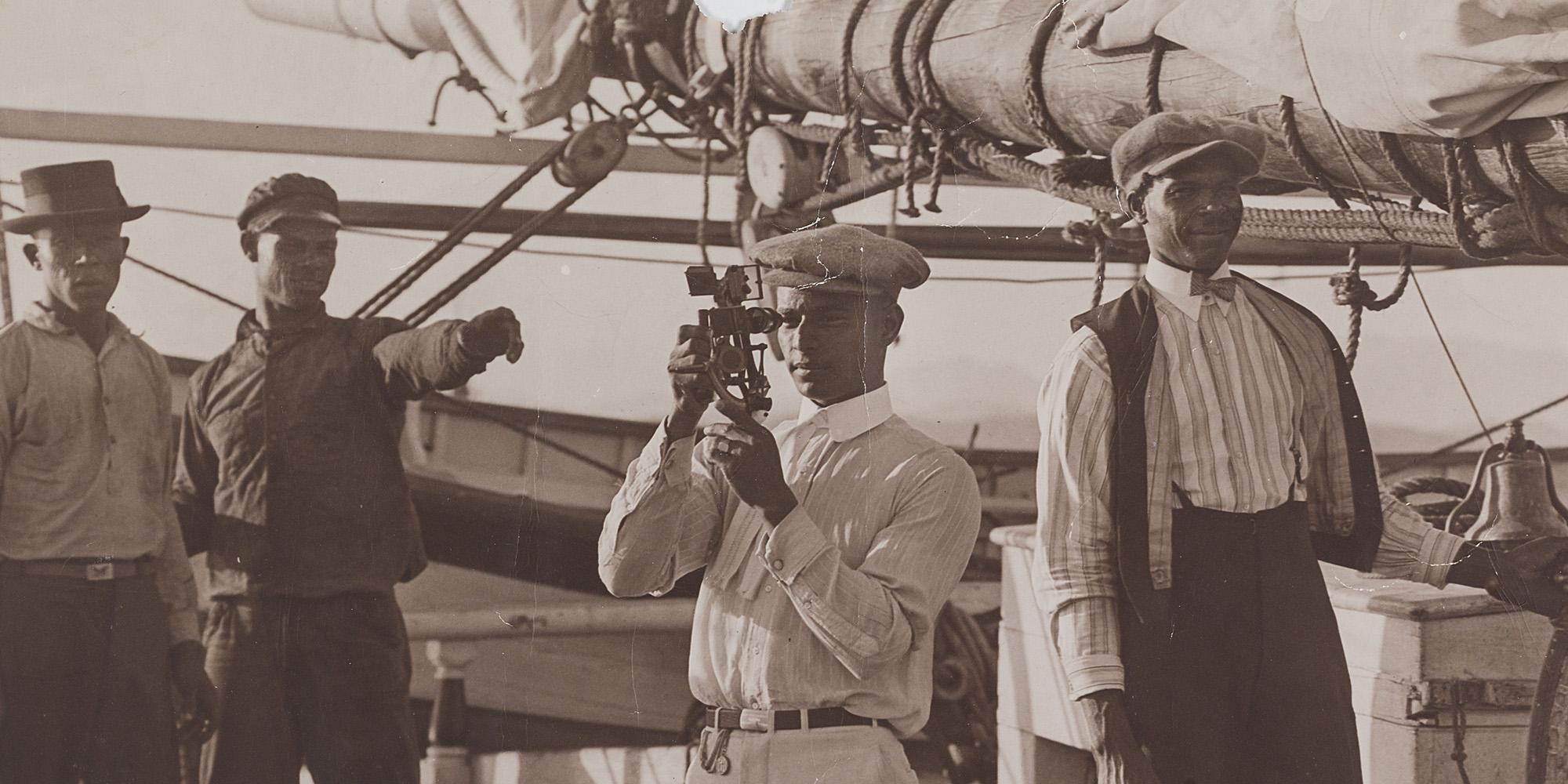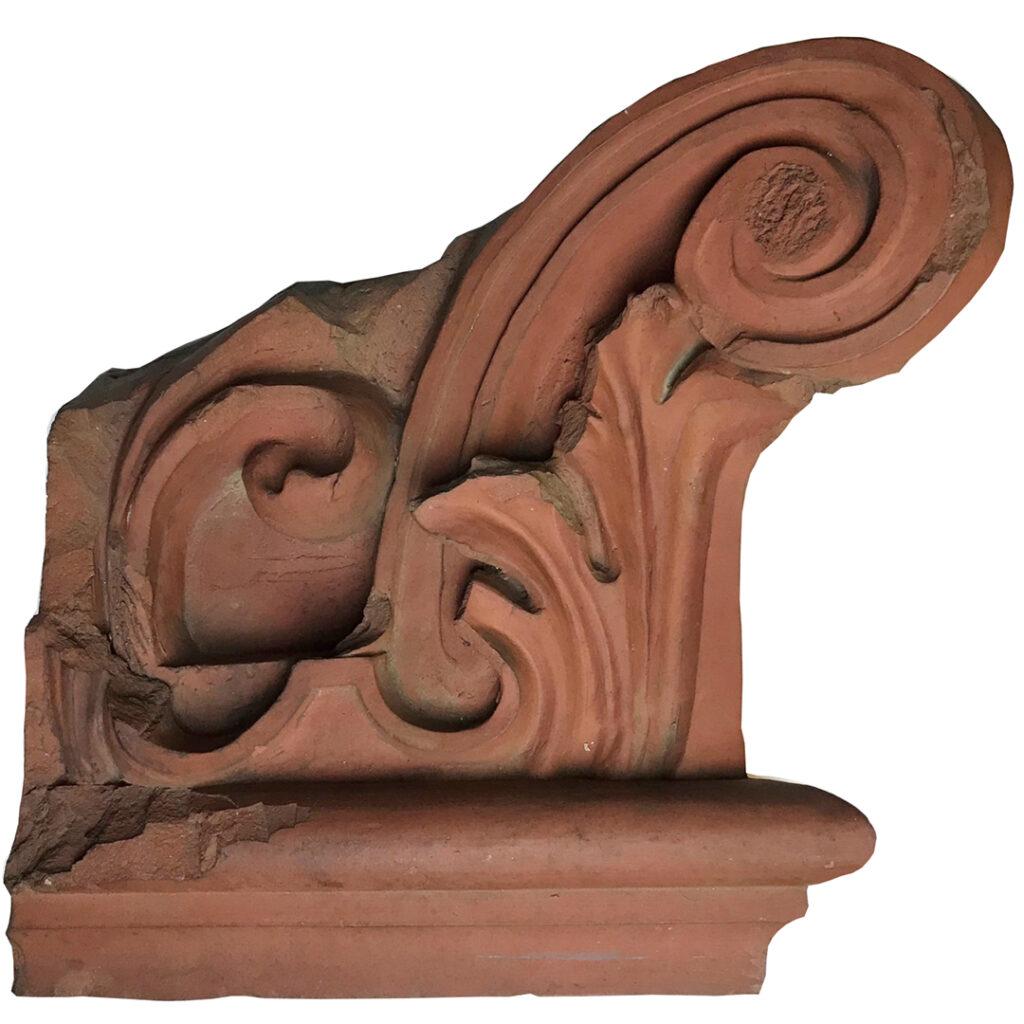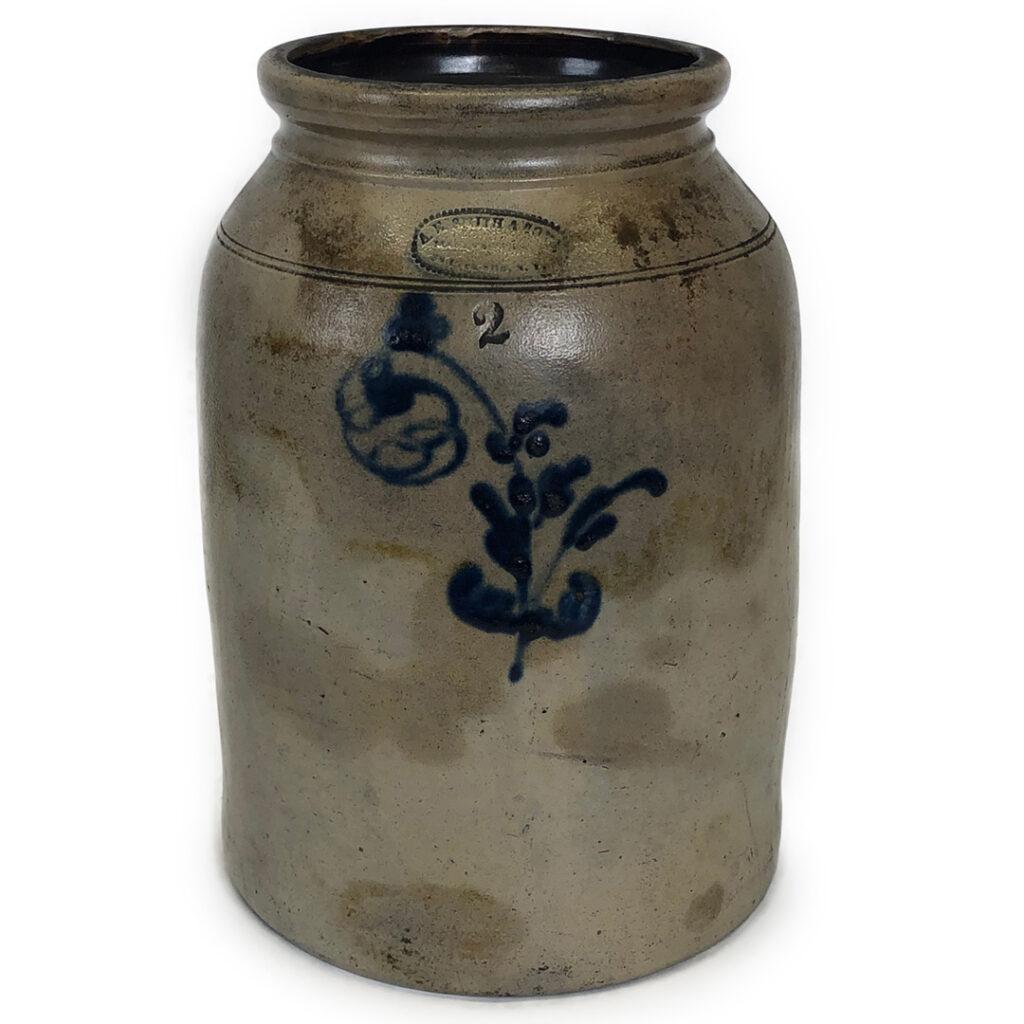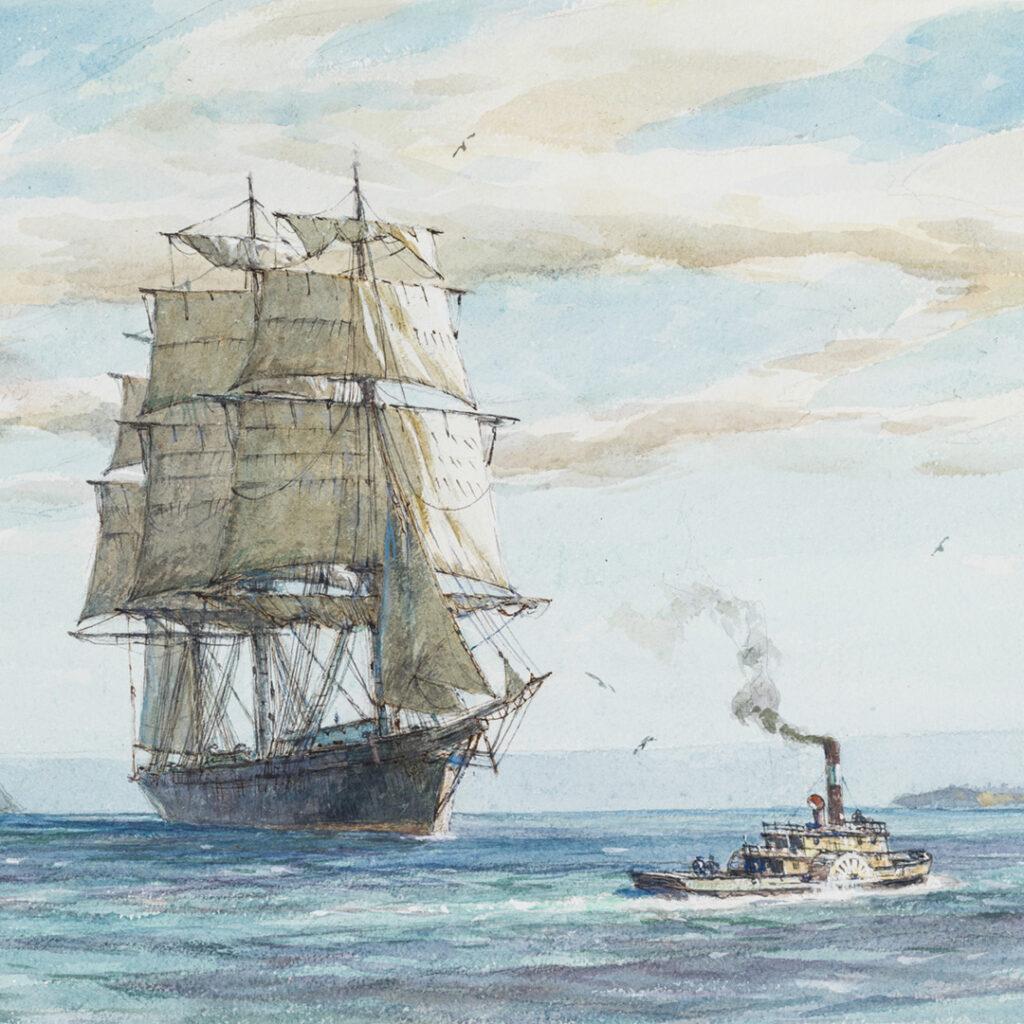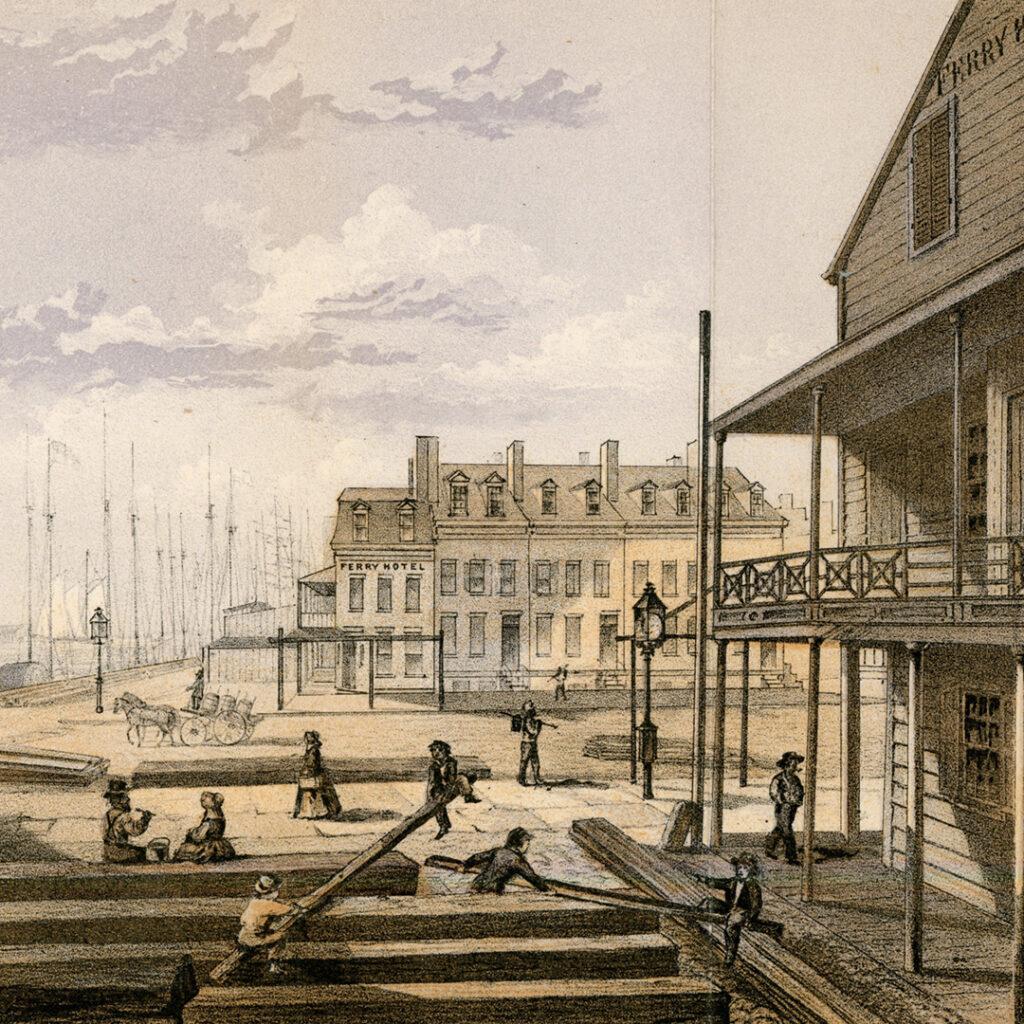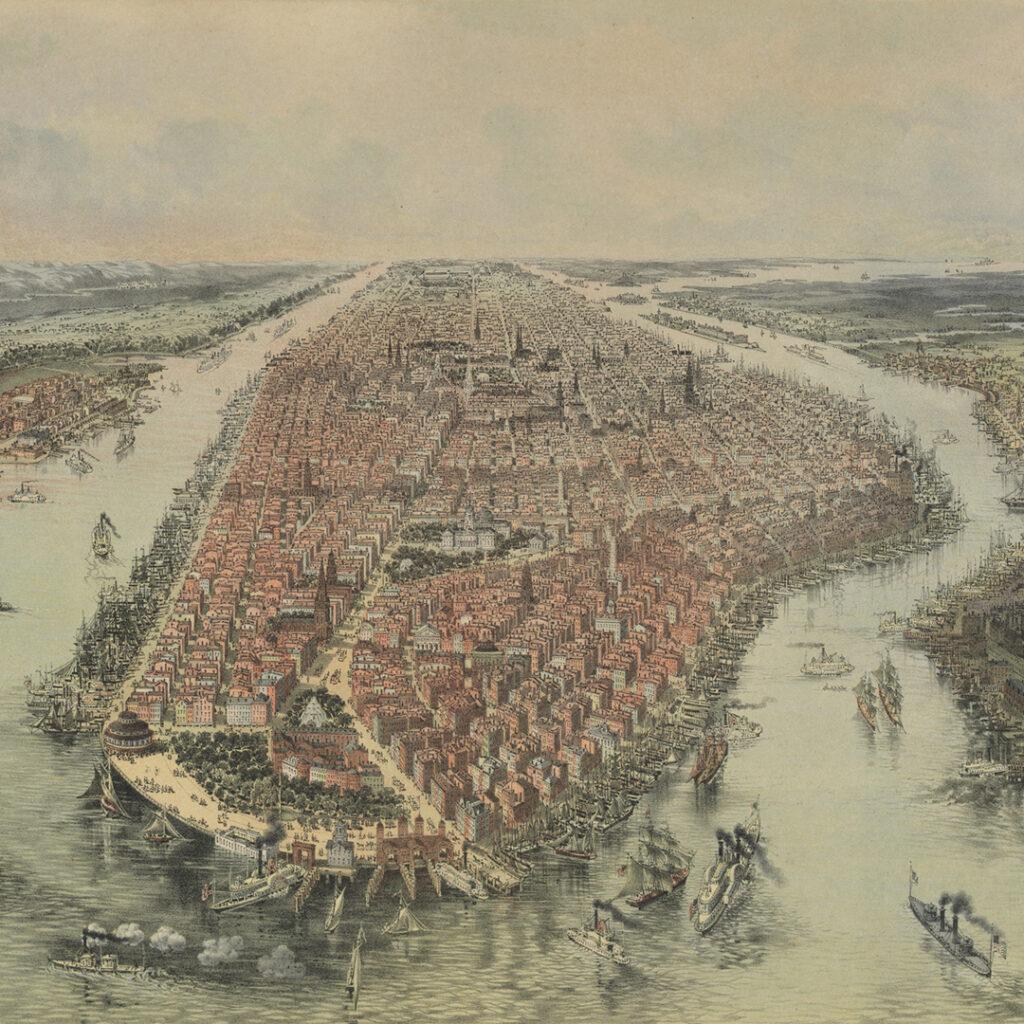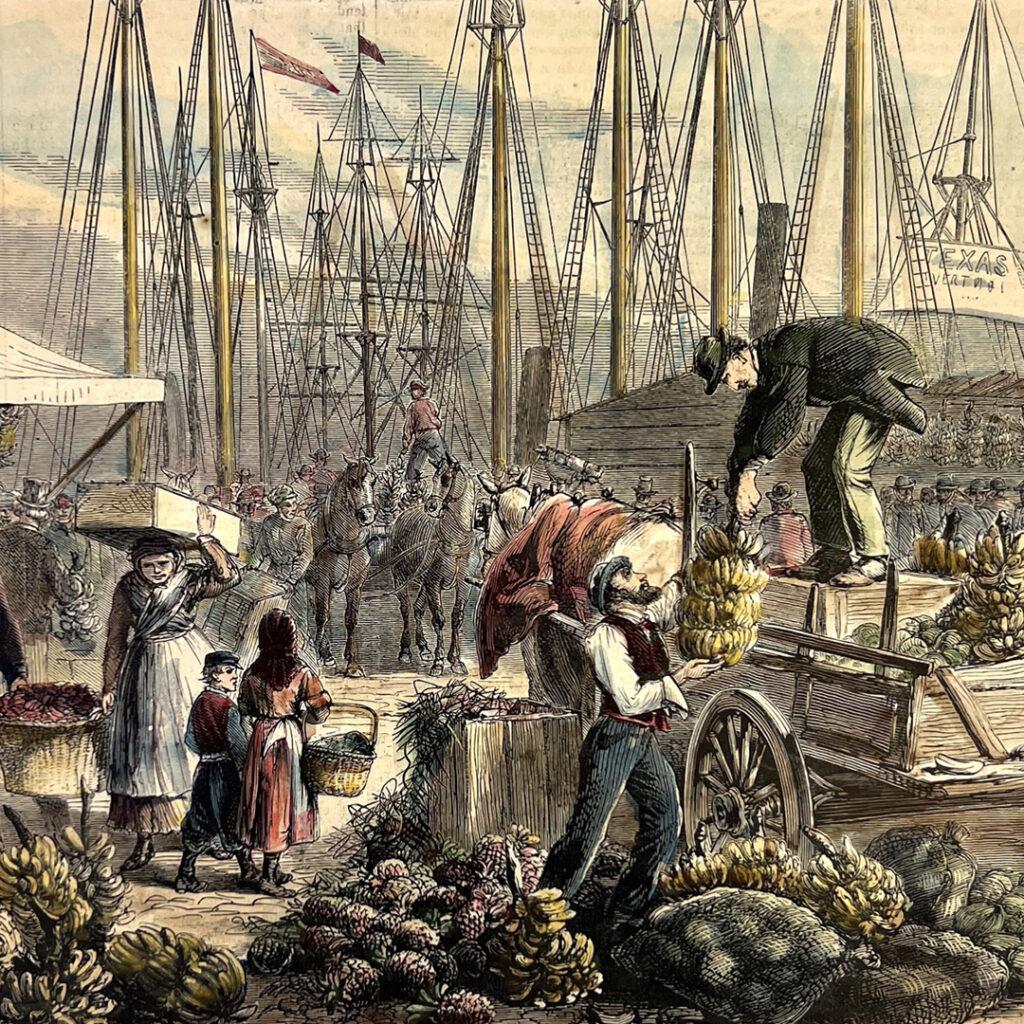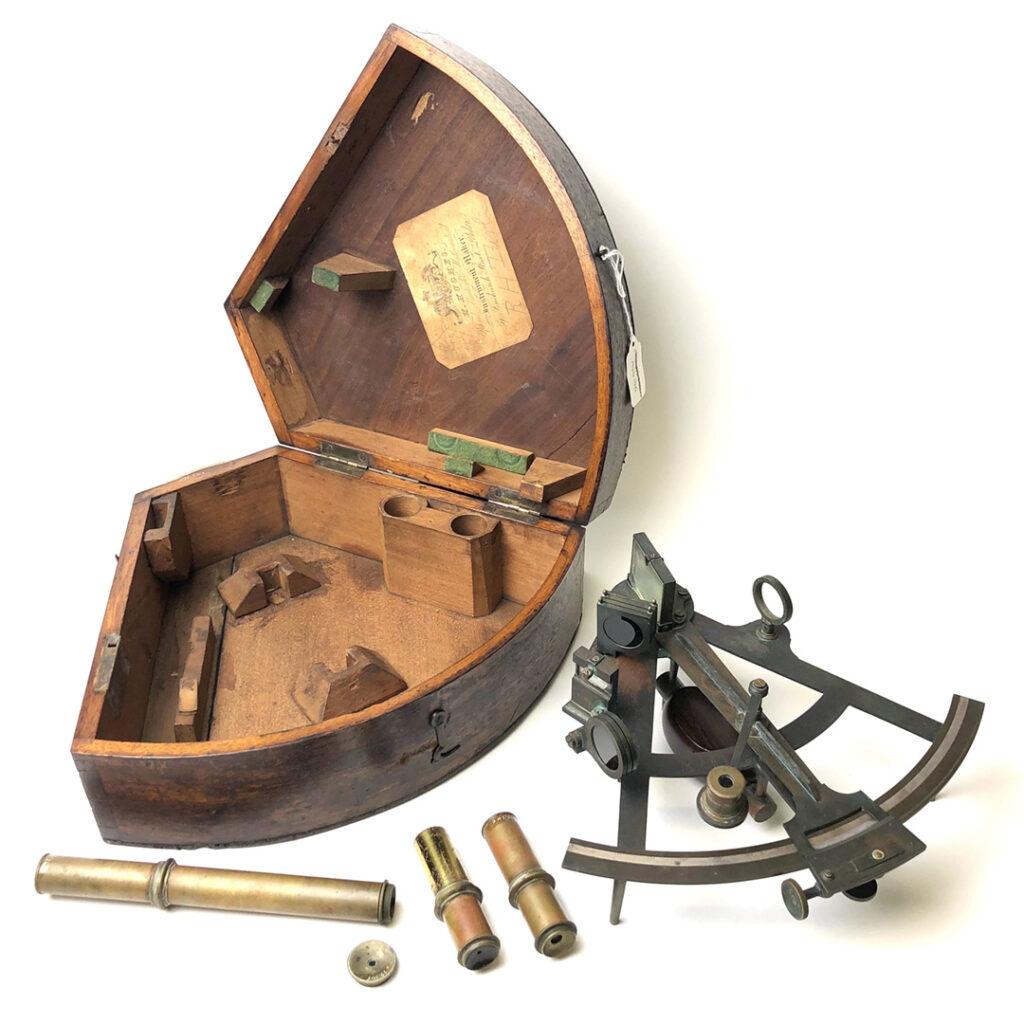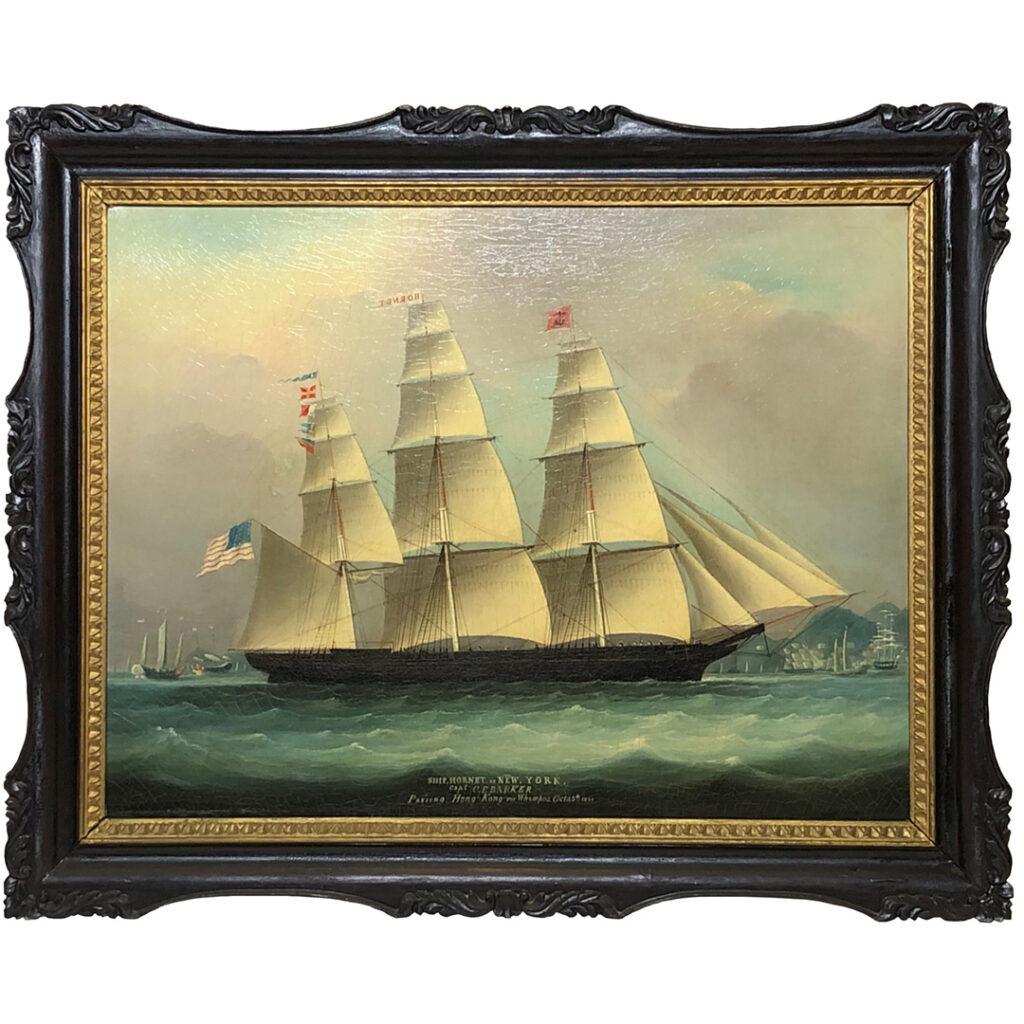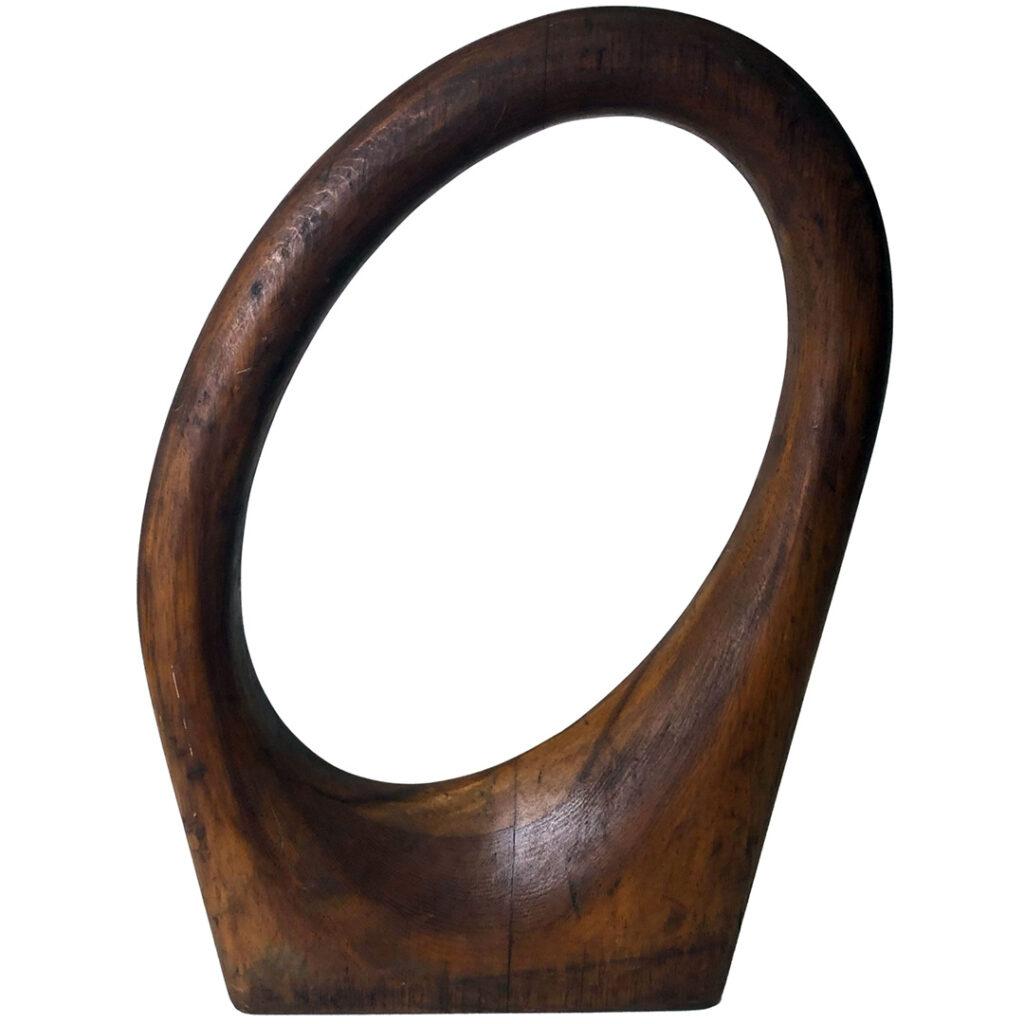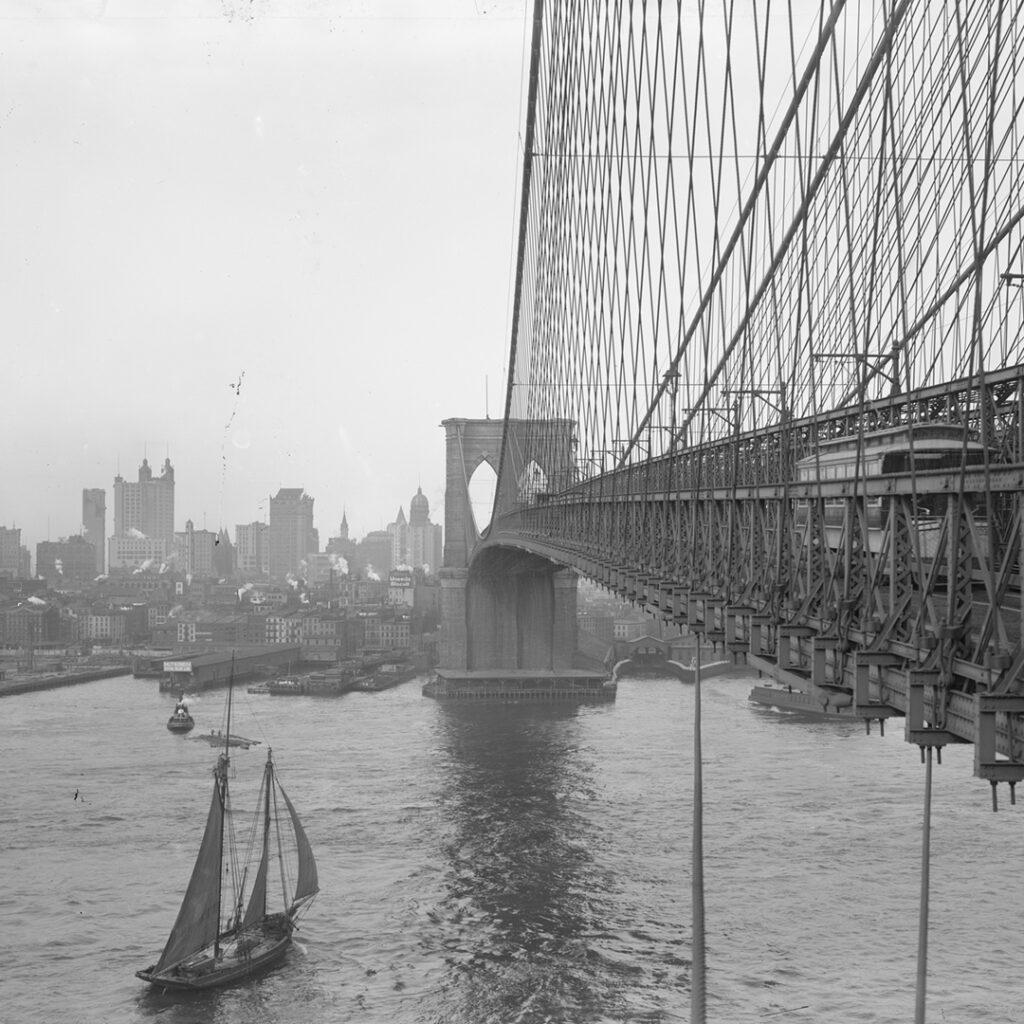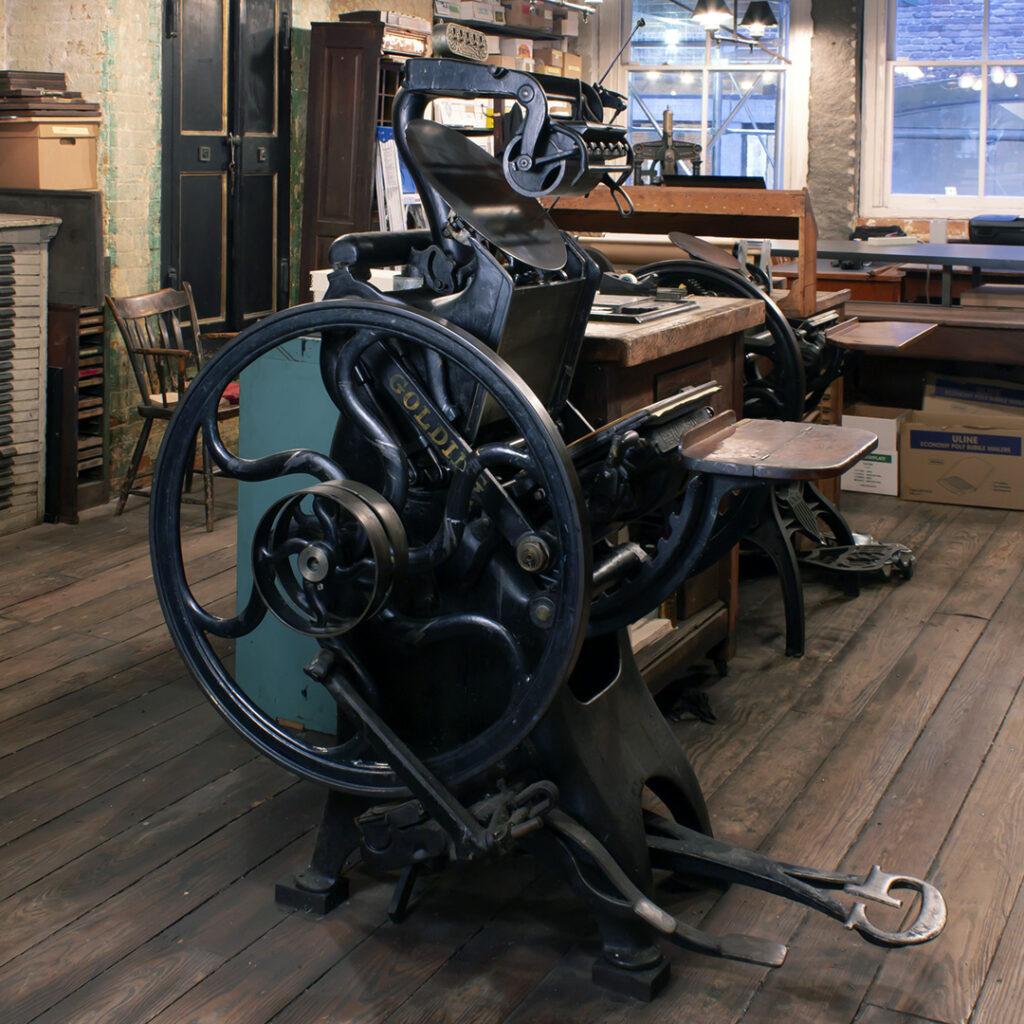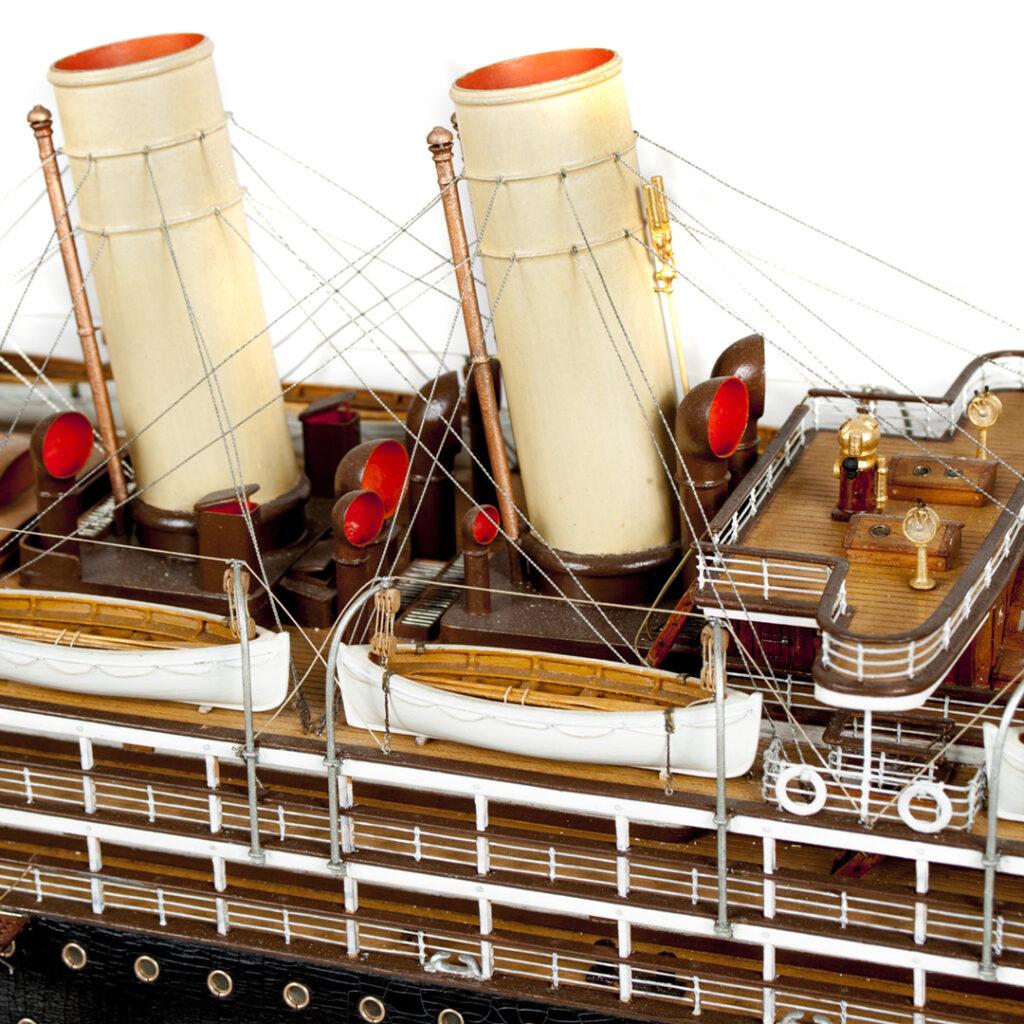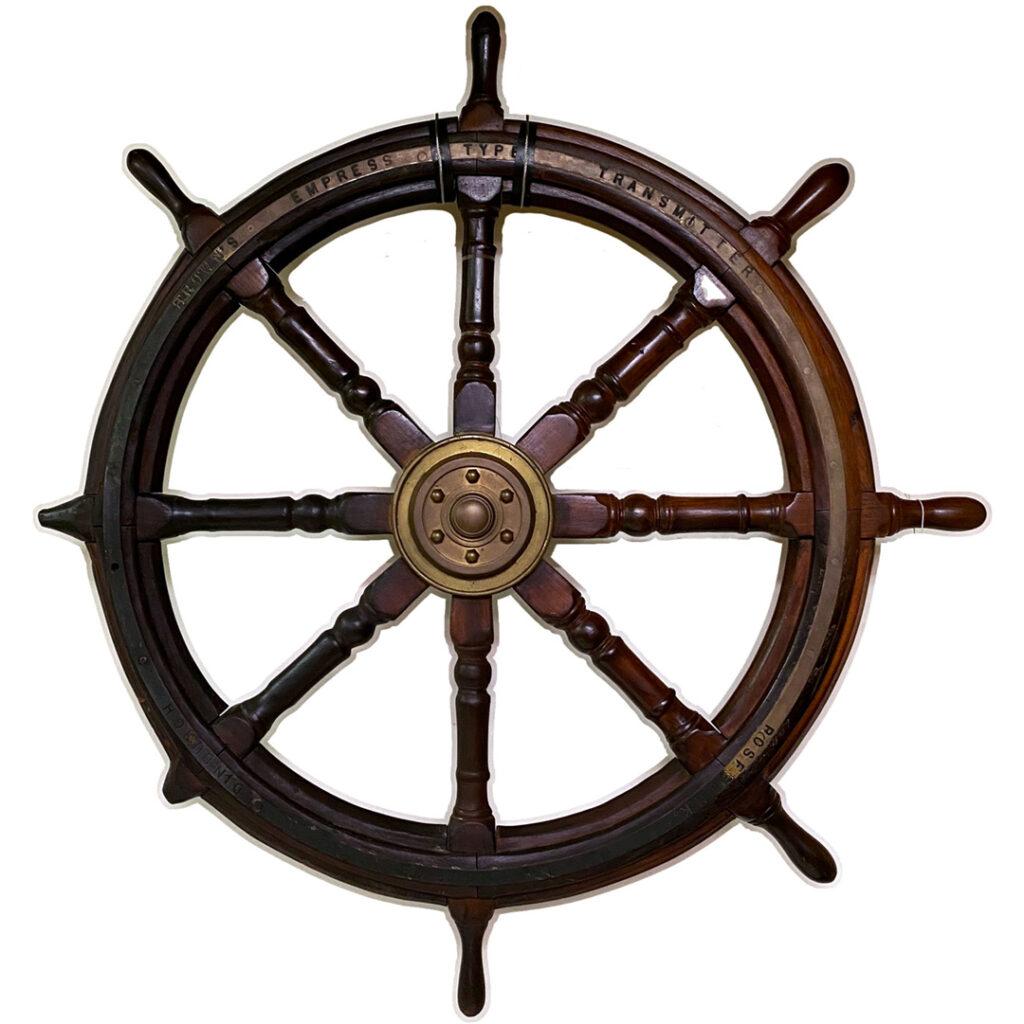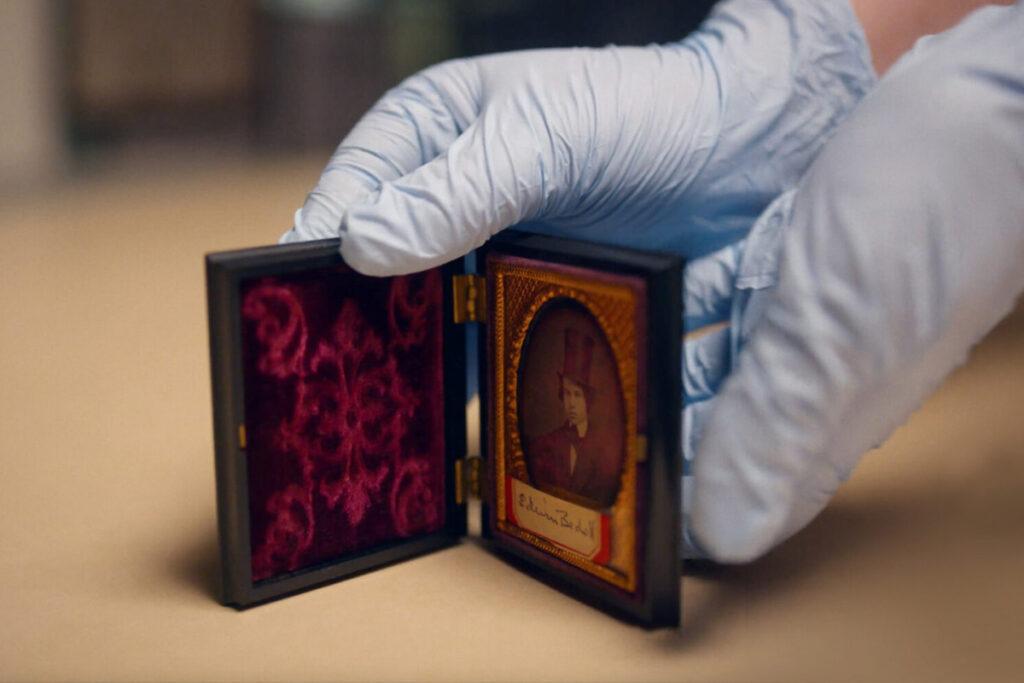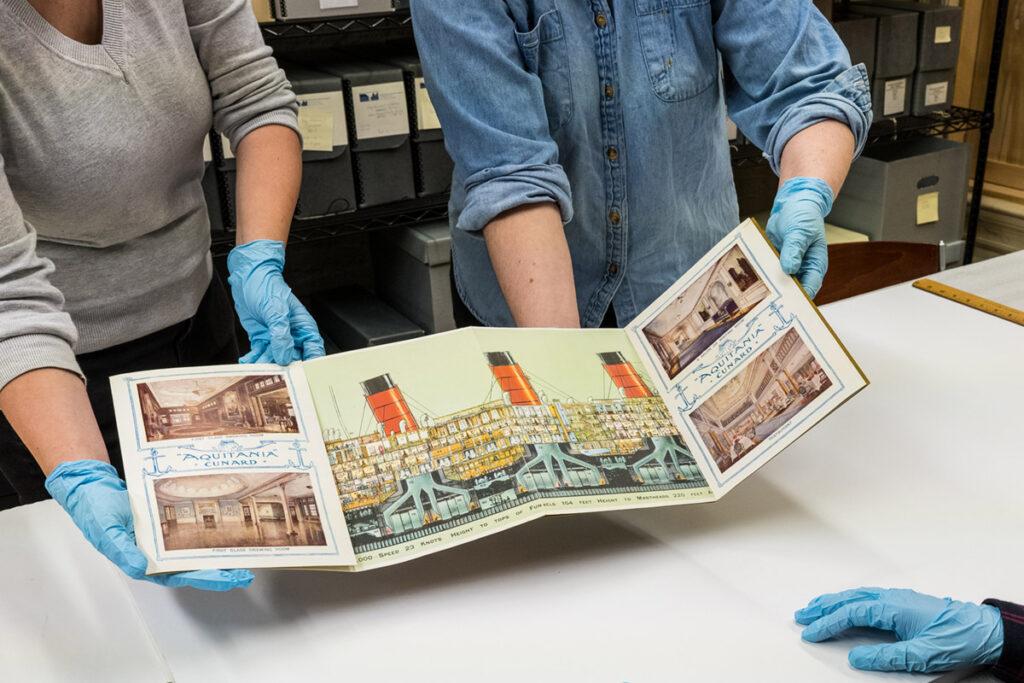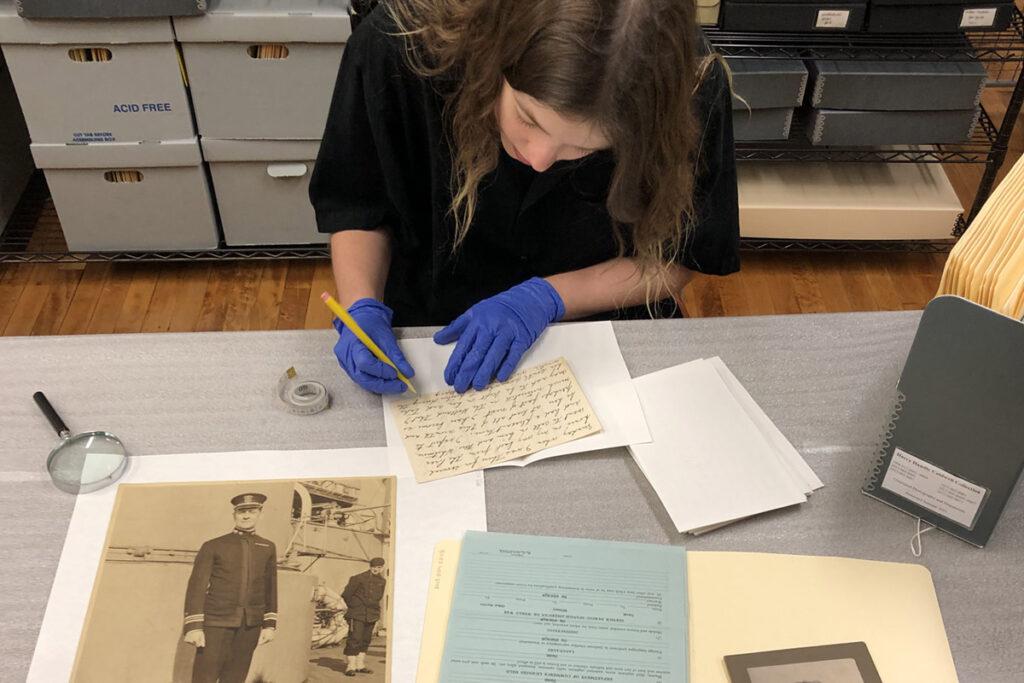The Seaport Museum collects a wide range of works of art, historical artifacts, and archival materials that document the history of New York City as a world port. Holdings reflect the legacy of many generous donors, some of whom contributed substantial collections. These donations help the Museum tell a broader range of stories about interaction with the sea, both globally and through time.
The Seaport Museum was founded in 1967 in part to collect ships, buildings, artifacts, and archival materials to recreate in the heart of New York City the historical seaport of New York. The collection rapidly expanded to include paintings, photographs, ship parts and gear, and various objects related to the businesses of the Seaport that chronicled notable experiences of New York port’s trades, architectural appearance, and cross-cultural interaction. Later, the collection expanded to include more fine art, ship models, scrimshaw, steamship and ocean liner ephemera, and historical objects tied to the letterpress printing, graphic art, and advertising industry, which supported the growth of New York as a financial powerhouse.
You can explore a selection of the Museum’s collections and archives on our free Collections Online Portal, a searchable database populated with objects covering a variety of mediums and subjects. The digital portal now features nearly 5,000 rarely-seen artifacts and pieces of ephemera from the late- 18th century to the 21st century that you can learn about from anywhere. Whether items are preserved in storage, displayed in Museum galleries, or on loan to fellow institutions, you can digitally discover some of the special pieces within the collections.
Highlights of the Collections
Architectural Elements
The collection of architectural elements and building components includes bricks, doors and windows, samples of wallpaper, cast iron and terra cotta ornaments, ironworks, and more. The objects are examples of the changing physical fabric of New York City, and particularly of the South Street Seaport Historic District.
Most of the artifacts belong to different adaptations and style iterations of Schermerhorn Row, a Georgian Federal-style counting house built between 1810–1812, and home of the Museum since the 1970s. The remaining artifacts belong to significant buildings that no longer exist, such as the 1882 Fulton Market building and the 1849 Edward Laing Stores.
Collections Chronicles Blog Posts About this Collection
“The Writer and the Wrecking Ball” by Martina Caruso, September 30, 2021.
“Brick by Brick. Examining the material that built New York” by Michelle Kennedy, October 28, 2021.
“Windows to the Past. How Routine Object Cleaning Shines a Light on Brooklyn Waterfront History” by Carley Roche, January 27, 2022.
Ceramics
This collection is a window into the creation and production of ceramics from the 17th century to the mid-20th century on a global scale. Artifacts include ordinary and ornamental earthenware pieces like jugs, pitchers, and figurines produced in New York and North America, as well as porcelain imported from China and “china-wares” produced in Western countries.
Artifacts also include celebratory transfer printing plates, and a wide range of dining and drinking ware produced in factories to be used on board the great ocean liners during the turn of the 20th century.
Collections Chronicles Blog Posts About this Collection
“Three Stories on a Plate. An intern’s analysis of the collection research process” by Clara Reigosa Lombao, June 26, 2022.
Clipper and Trade Cards
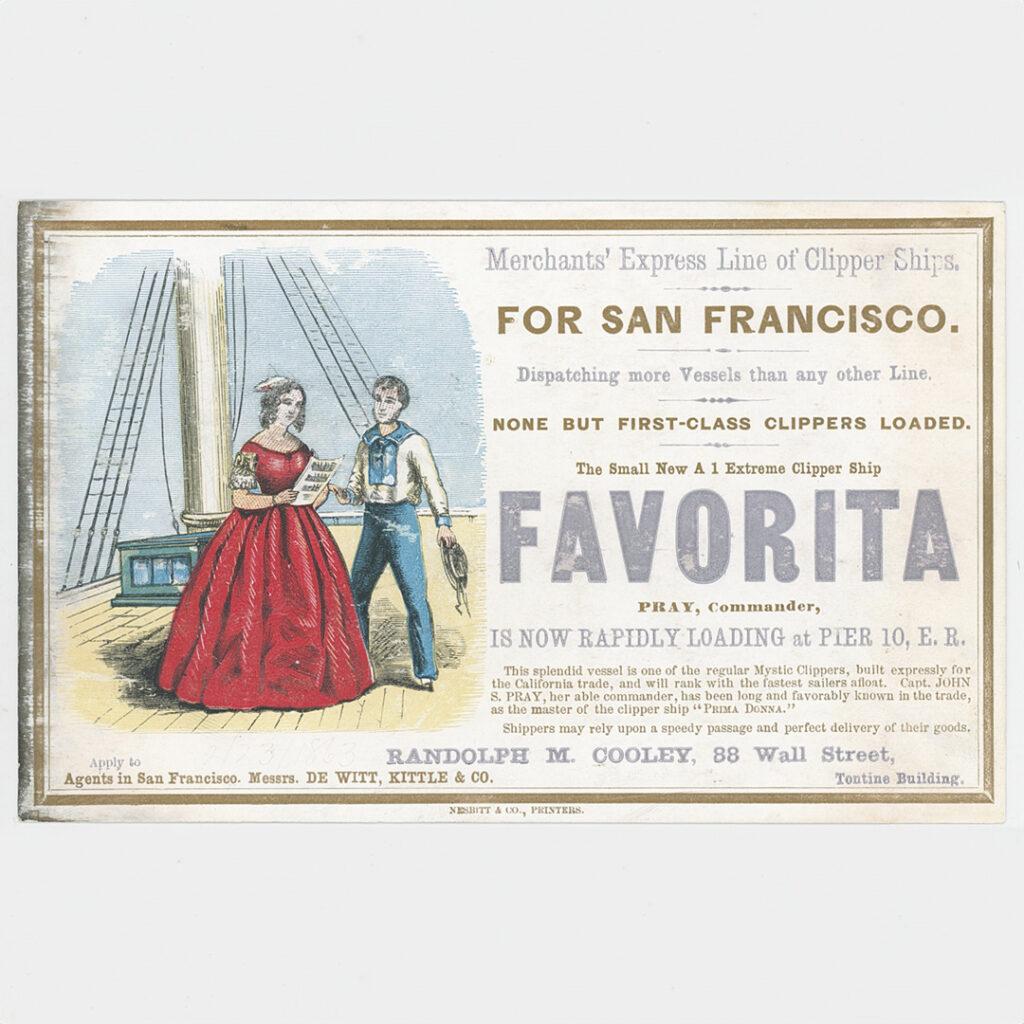
During much of the 19th century, the creation and dissemination of trade cards was a huge part of advertising. Trade cards were attractive, eye-catching ways for businesses to show off their products and services. These items were extremely popular and were used in most industries.
Clipper cards, a specific type of trade card, advertised the shipping trade mainly between New York and California during the California Gold rush.
Clipper and trade cards are now rare and much prized by collectors, both for their historical significance and for their typographical and visual interest. The Museum owns over 1,200 of these special pieces of ephemera.
Collections Chronicles Blog Post About this Collection
“Hidden Gems: Clipper Ship Cards” by Michelle Kennedy, June 25, 2020.
Drawings and Watercolors
The collection of drawings and watercolors includes depictions of New York City’s waterfront and landmarks, renowned vessels, and marine subjects from around the world. Items include a wide range of works on paper, from preparatory studies and sketches, to finished works produced for New York City businesses and maritime publications, as well as unique compositions made by artists and sailors documenting their experiences at sea and in ports.
Due to the fragile nature of these works on paper, individual drawings and watercolors are only exhibited for short periods of time. The collection includes notable artists like Conza Howell (1902–1987), Gordon Grant (1875–1962), Keith Miller (b. 1949), and Naima Rauam (b. 1946).
Collections Chronicles Blog Post About this Collection
“Conza Howell’s Silhouettes. How silhouettes helped spotlight artists and lesser-known people” by Martina Caruso, March 18, 2021.
Illustrations from D.T. Valentine’s Manual of the Corporation for the City of New York (1841–1870)
The D.T. Valentine’s Manuals were books produced annually from 1841 to 1870 and contained hundreds of rare beautifully hand coloured contemporary and historical lithograph maps and views of New York City.
David Thomas Valentine (1801–1869), as the Clerk of the Common Council of New York City, edited and published the series of books on the history and contemporary facts of New York City. Illustrations show public gardens, famous residencies, hotels, museums, taverns, and theaters in or near the city, ca. 1776–1864.
Collections Chronicles Blog Post About this Collection
“19th Century Tavern Crawl. A look at the stories behind a handful of Manhattan’s taverns in history” by Carley Roche, June 18, 2020.
Lithographs and Prints
This outstanding collection is composed of over 2,500 works on paper primarily depicting New York City scenes, New York Harbor landscapes, the American Civil War, portraits of celebrated clipper ships and ocean liners, as well as items related to popular culture, covering topics such as P. T. Barnum’s American Museum, political cartoons, and recreational activities such as theater, opera, and sports of the period.
Primarily focused on popular American lithographs produced in the mid- to late- 19th century by New York City firms such as Currier & Ives and Endicott & Co.,, this collection also includes a growing number of 20th century works on paper. Notable artists include Frances Palmer (1875–1962) and John A. Noble (1913–1983).
Manuscripts and Archival Collections
The manuscripts and archival collections spans the mid-18th century to late-20th century and augments and complements other elements of the collections. These includes both everyday paper-based objects such as newspaper clippings, invoices, letters, business cards, and postcards, as well as broadsides, music sheets, and advertisements illustrating both mercantile and recreational activities of New York City, and the close connection between the bustling port and graphic arts.
Highlights include the Harry Handly Caldwell Collection, the Barkentine Herbert Fuller Document Collection, Fulton Fish Market and South Street Seaport Business Documents Collection, Miller Family Beefsteak Collection, and the Wendell Lorang Maritime Postcard Collection.
Collections Chronicles Blog Post About this Collection
“Missives from the Past. Postcards as artifacts, ephemera, and personal documents” by Emily Drachman and Julia Lee, August 5, 2021.
“Extra! Extra! Read all about it! Newspaper Clippings Now on the Collections Online Portal” by Martina Caruso, June 29, 2023.
“Cursive Conundrums” by Elena Abou Mrad and Nick Lockyer, November 14, 2024.
Nautical Instruments and Shipwright Tools
South Street waterfront district was a place to craft, market, and export their wares for generations of artisans, carpenters, workers, riggers, and sailmakers.
The collection includes navigational instruments used by sailors to monitor their environment and their vessels, along with thousands of historic and antique tools used for shipyard and port work by workers and riggers.
The instruments used for navigating and charting at sea include compasses, sextants, octants, chronometers, parallel rules, marine protractors, binoculars, telescopes and more. The oldest object in the collection is an ivory 1625 portal sundial manufactured by Hans Tröschel II, or the Younger, (German, probably born 1599, died before 1634) from Nuremberg, Germany.
Collections Chronicles Blog Post About this Collection
“Tools of the Trade. The steps of caring for the Museum’s tools collection” by Carley Roche, February 22, 2024.
Ocean Liner Collections
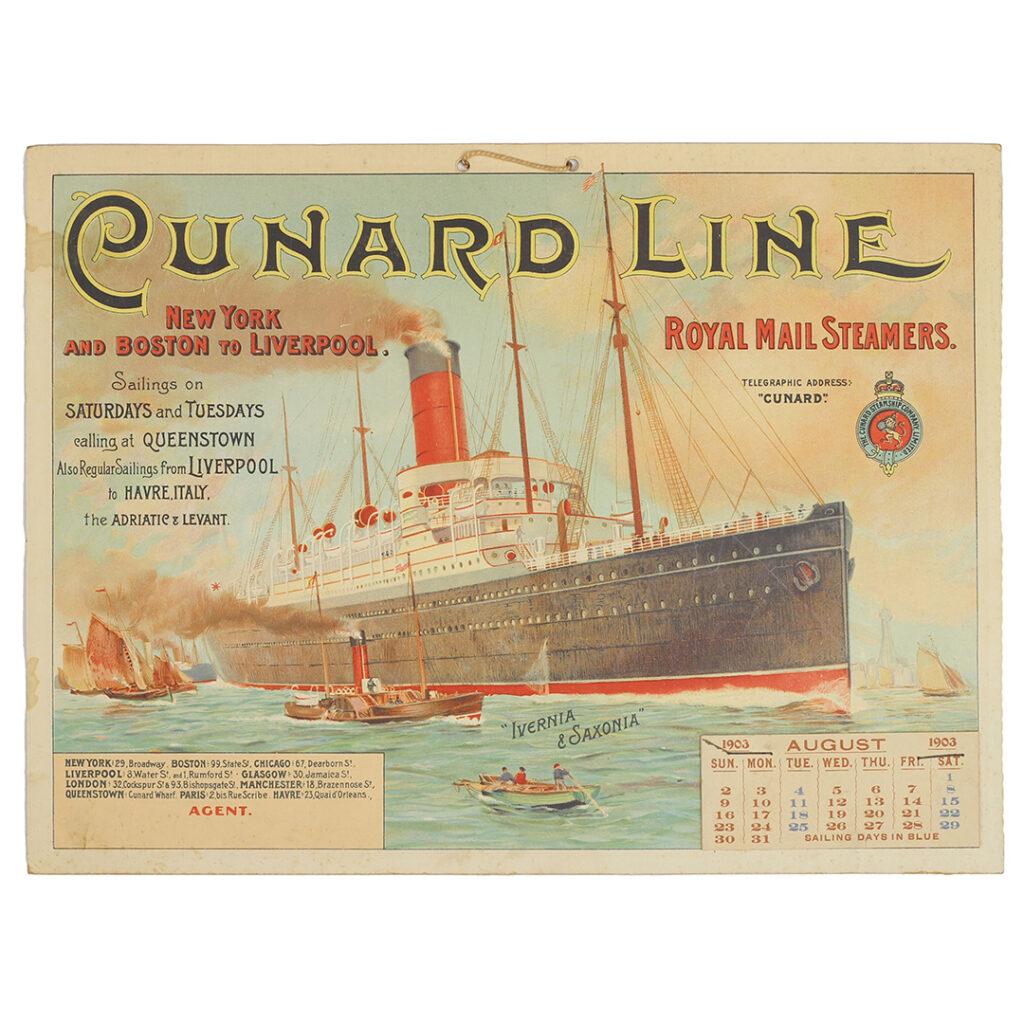
An ocean liner is a ship with a fixed route and scheduled to leave at a specific date and time. The first ocean liner set sail in January 1818 from Peck Slip, just a couple of blocks from the Seaport Museum. By the 1860s, steamships were replacing sailing ships, and transporting immigrants across the Atlantic was big business.
The Museum holds two major ocean liner collections: the Der Scutt Ocean Liner Collection and the Ocean Liner Museum Collection. In addition, this collection includes an array of additional smaller donations related to ocean liner and cruise ships materials including a 1935 builder model of RMS Queen Mary and many other ship models, travel posters, ephemera and memorabilia.
Collections Chronicles Blog Post About this Collection
“Yesterday’s Specials. An overview of menus from passenger ships 1860s to 1960s” by Michelle Kennedy, November 12, 2020.
“Recent Acquisition: Captain Högemann’s Book” by Michelle Kennedy, April 1, 2021.
“Arriving in the Port of New York. US Customs and ocean liner travelers in the mid 20th century” by Michelle Kennedy, July 8, 2021.
Paintings
This collection focuses on 19th and 20th century oil paintings that illustrate the importance of international commerce in New York Harbor during the “Golden Age of Sail,” including works by renowned marine painters of the 19th and 20th century, including James E. Buttersworth (1817–1894), Gordon Grant (1875–1962), Antonio N.G. Jacobsen (1850–1921) and Samuel Walters (1811–1882). The paintings depict seascapes, harbor views from different ports of the world, as well as portraits of ships and captains.
Highlights include portraits of Peter and Simon Schermerhorn, builders of Schermerhorn Row (ca. 1810–1812) and a 9-foot long birds-eye view of New Amsterdam as it appeared in 1660.
Patterns for Casting
Building a ship is a complicated process. One portion of the process that is especially important involves casting the metal needed for individual technical pieces that are typically found deep within the ship. Wood patterns, like the ones in this collection, create molds when sand is pressed around the shape. The pattern is then removed to allow molten metal to be poured into the mold to create the desired piece.
Wood patterns help speed up the shipbuilding process by allowing the creation of hundreds of molds in the time it would take to hand-make one. Part of the collection of wood shipyard patterns was produced by the New York Naval Architectural firm Gibbs & Cox, while others were manufactured by the historic Ira S. Bushey Shipyard, formerly located on Gowanus Creek, Brooklyn.
Collections Chronicles Blog Post About this Collection
“The Ira S. Bushey & Sons Shipyard Collection” by Martina Caruso, October 29, 2020.
Photographs
This collection assists us to tell the story of photography across three centuries, helping us understand why and how pictures are made, and the important role the medium has played in shaping visual cultures across the world.
The earliest photograph in the collection is a crystal porcelain-type dated ca. 1873-1876 depicting Mr. Edmund Seaman (1832–1888) when he was the Captain of the Port of New York. Since then, the collection has grown to encompass works representing many different photographic techniques, including lantern slides and glass plates negatives, daguerreotypes, tintypes, cartes de visite and cabinet cards, stereographic cards, albumen, gelatin silver and inkjet prints.
Collections Chronicles Blog Post About this Collection
“Aerial Photographs from Fairchild Aerial Surveys, Inc.,” by Martina Caruso, August 20, 2020.
“Hidden Gems: Glass Plate Negatives. Caring for the George P. Hall & Son Collection” by Martina Caruso, November 11, 2021.
“Archival Detective Work. The research process for the Captain Frank Ley Collection” by Elena Abou Mrad, July 19, 2024.
Printing Presses
Printing presses were once the backbone of the job printing industry. With this equipment the industry excelled at printing small batches of invoices, receipts, labels, tags, and the variety of business stationery to support the ever bustling seaport.
In the 19th century, printing offices proliferated in Lower Manhattan, where they served shipping companies and the dozens of other merchants who formed a culture of commerce centered around the port. By century’s end, New York City boasted over 700 printing offices staffed by 8,000 workers. From one-man, single-press operations in basements, to multi-story printing plants that employed hundreds of journeymen, they generated a flurry of printed materials that blanketed South Street and beyond.
Bowne & Co. Stationers uses the historical equipment from the Museum’s working collection on a daily basis and regularly invites the public to “roll up their sleeves” and learn about letterpress printing through monthly and seasonal workshops and open houses.
Collections Chronicles Blog Post About this Collection
“One Printing Press and Three Museums” by Rob Wilson and Martina Caruso, June 10, 2021.
Scrimshaw and Nautical Folk Art
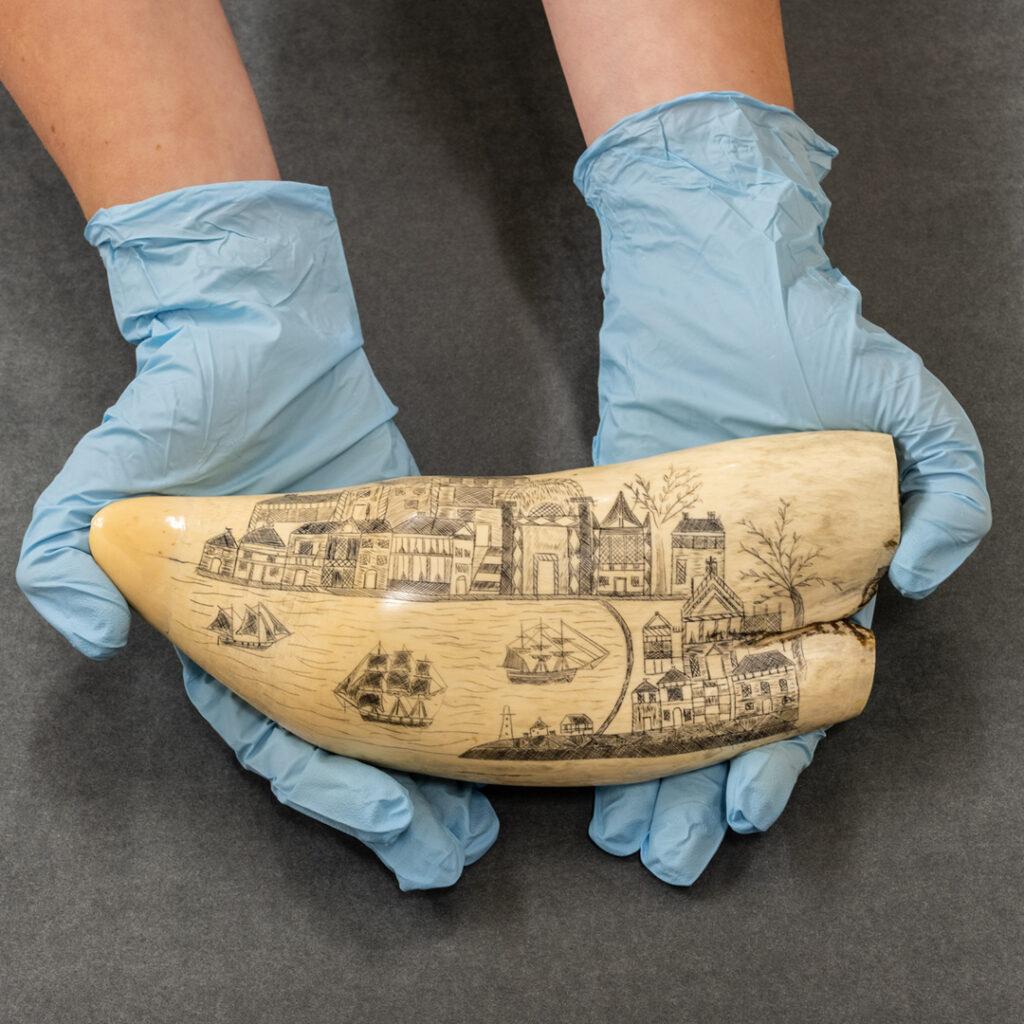
During long ocean voyages, crew members created decorated boxes, whimsies in bottles, nautical carvings and scrimshaw. These works capture the distinctive creative spirit and emotional impulses generated by seafaring experiences.
Scrimshaw is the art of carving on marine mammal ivory and was primarily made by 19th century whalers while at sea. These objects include purely decorative engravings and sculptures, as well as functional tools used by sailors themselves.
The Museum holds a remarkable collection of scrimshaw from the mid-19th century and early-20th century, including engraving on natural whale teeth and tusks, swifts, busks, pie crimpers, canes, clothespins, ditty boxes, and needles.
Highlights from this collection are not available in the Collections Online Portal at this time.
Collections Chronicles Blog Post About this Collection
“The Scrimshawed Chicken-Man. Adventures in Researching a Unique Whale Tooth” by Michelle Kennedy, July 16, 2020.
“Rethinking Sailors’ Valentines. Investigations on This Charming Craft” by Martina Caruso, February 3, 2023.
Ship Models
The models housed in this collection represent vessels dating back to New Amsterdam through modern container ships. Ship models were built by sailors to commemorate their voyages, by shipping lines to advertise their vessels, and by amateur artists seeking to model ships that captured their interest.
Scale models in the Museum collection include merchant and fishing vessels, working harbor vessels, ocean and passenger liners, warships and Navy vessels, and other crafts of all sorts and sizes. Among the 2,400 models are Napoleonic-era Prisoner-of-War ship models, and 20th century builder’s models of ocean liners, and waterline models by renowned builder Charles K. Van Ryper (1891–1964).
Collections Chronicles Blog Post About this Collection
“Van Ryper Ship Models. The Models that Made the Models” by Kenzie Grogan, December 15, 2022.
“Queen Mary is in the House! Discover the preservation of this monumental ship model” by Martina Caruso, January 30, 2025.
Ship Parts and Equipment
The Seaport Museum holds a wide variety of historic ship parts and equipment, such as ship bells, capstans, binnacles, wood paneling, nameboards, anchors, and more. These artifacts largely represent ships that are no longer extant, including Hudson River steamboats, working vessels of New York Harbor, and the great ocean liners of the 20th century.
Highlights include the ship wheel of the ocean liner SS Normandie, the famous ocean liner that burned at her West Side pier during World War II; wood paneling decoration from RMS Mauretania, originally installed near ceiling in first-class smoking room; and wood paneling from the 1865 steamboat SS Dean Richmond.
Tattoo Collection
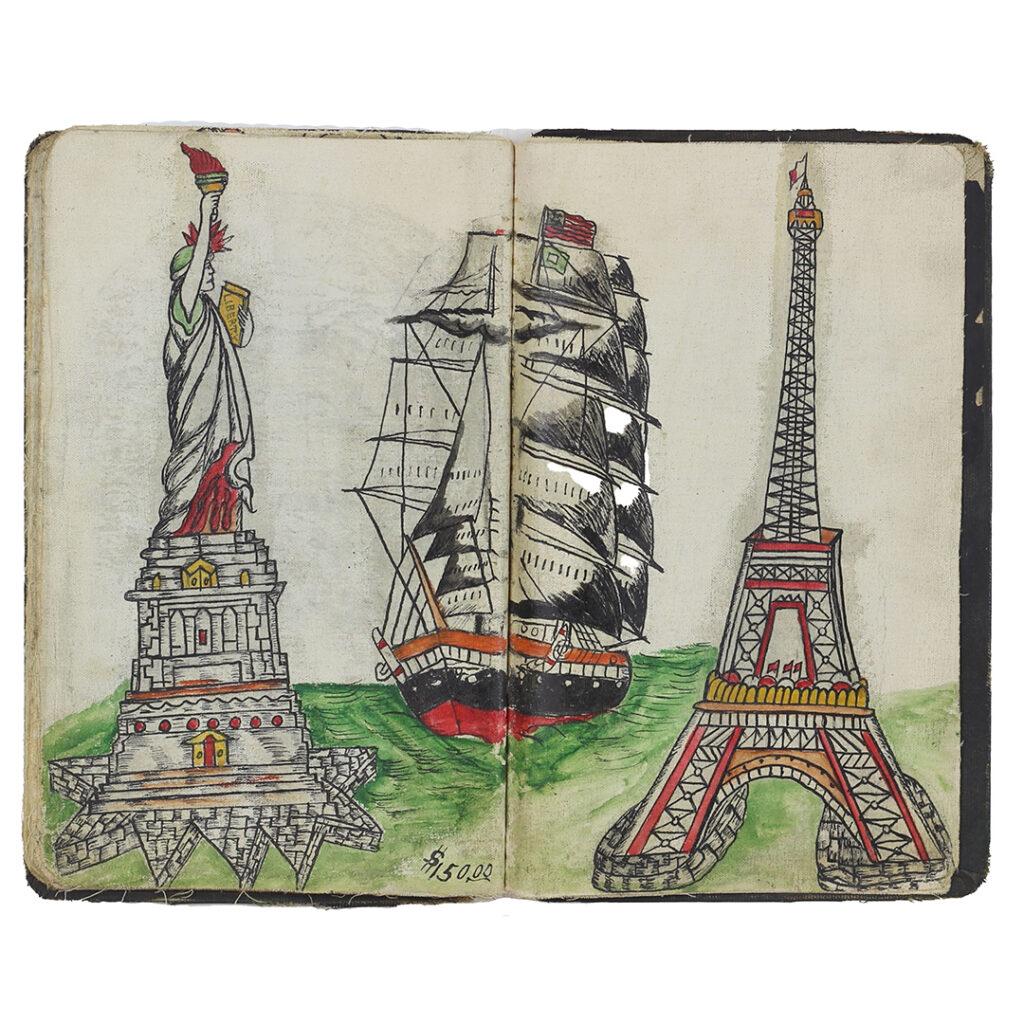
The Alan Govenar and Kaleta Doolin Tattoo Collection at the Museum examines the life and work of Augustus “Gus” Wagner (American, 1872–1941). Wagner traveled the world as a merchant mariner and tattoo artist from 1898–1902 and then pursued a career as a professional tattoo artist and tattooed man, traveling across the United States, between 1903–1941. The collection is the most comprehensive of a single American tattoo artist during the early 20th century.
The collection includes tattoo flash, hand tattooing equipment, photographs, and a 400-page scrapbook composed of press clippings, postcards, business cards, sketches, and photographs, related to Gus’s career as a sailor and tattoo artist.
Highlights from this collection are not available in the Collections Online Portal at this time.
The donors retain all reproduction rights to the entire collection and each work of art. The Museum is able to permit the examination, study and research of the works of art for the general public, following best museum practices. Please contact the Collections and Archives Department for more information at [email protected].
Learn More About the Collections
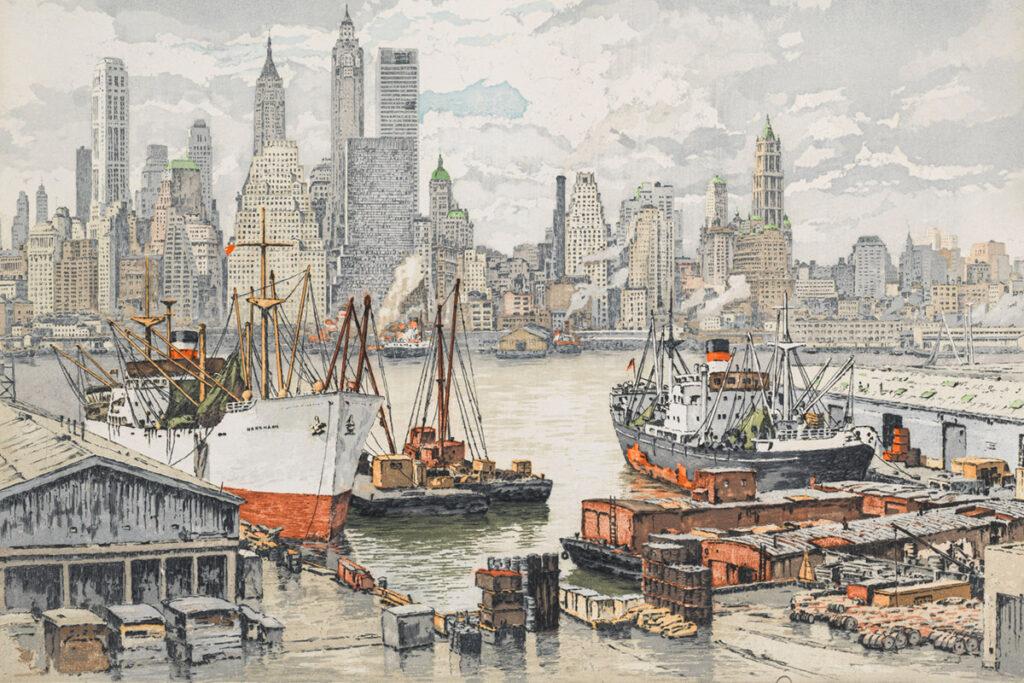
About the Collections
The collections and archives of the South Street Seaport Museum document the rise of New York as a port city, and its role in the development of the economy and business of the United States through social and architectural landscapes with over 28,000 works of art and historical artifacts, and over 80,000 archival materials.
Acquisition Guidelines
The Seaport Museum’s Collection Management Policy, last revised in May of 2024, outlines the scope of the Museum’s collection, explains how the museum grows, cares for and makes collections available to the public, and clearly defines the roles of the parties responsible for managing these artifacts.
Research Policies
Conducting research is a vital part of the Seaport Museum’s work. The Museum is actively engaged in a complete inventory of its collections and archives. This ongoing project will improve future public access to the materials in our care and ensure that items are documented and preserved for future generations.
Collections Chronicles Blog Posts
Read articles written by the Seaport Museum’s Collections and Exhibitions team. These engaging posts share insights about inventory and rehousing projects that staff and interns are working on, research about specific artifacts, and explore other areas of interest surrounding the Museum’s collections.
